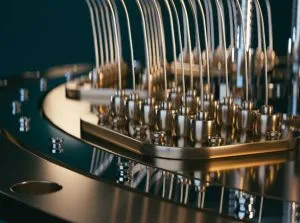Such a network would have fibre optic long-distance communication, possibly many km long, connecting microwave qubits.
“The technology could serve as a translator for quantum computers, enabling them to talk to each other over long distances and converting up to 95% of a signal with virtually no noise. And it all fits on a silicon chip,” according to the university.
“Most importantly,” said project researcher Mohammad Khalifa, “this device preserves the quantum connections between distant particles and works in both directions. Without that, you’d just have expensive individual computers. With it, you get a true quantum network.”
The optical part of the device is an oval (actually running track-shaped) silicon optical waveguide encased in SiO2. Passing this closely is an input-outputr optical waveguide through which passes the optical signal and, in the opposite direction, an optical pump.
The proximity of the waveguides allows evanescent coupling to move the two optical signals between the input-output and the oval – which is shaped and sized to resonate optically for both the pump and optical signal frequencies.
Around the oval is a planar microwave resonant cavity, coupled to an external microwave port.
The two resonators (with three resonances) are carefully designed to confine the optical and microwave energy into the same space, where deliberately introduced non-linear effects promote ‘three-wave mixing’.
“The breakthrough lies in tiny engineered flaws, magnetic defects intentionally embedded in silicon to control its properties,” said the university. “When microwave and optical signals are precisely tuned, electrons in these defects convert one signal to the other without absorbing energy, avoiding the instability that plagues other transformation methods.”
These key defects, known as ‘colour centres’, are spin-bearing and also optically active. Microwave photons can magnetic couple into (and out of) their spin transitions, while optical photons can couple out of (and in to) their orbital transitions.
Conversion efficiency is high, and losses are low such that “the device also runs efficiently at extremely low power, just millionths of a watt,” added the university.
This is remains a theoretical study, and quantum computers are only fledglings.
“We’re not getting a quantum internet tomorrow, but this clears a major roadblock,” said fellow researcher Joseph Salfi. “Reliably sending quantum information between cities remains challenging. Our approach could change that.”
For those who understand three-wave mixing, the paper ‘Robust microwave-optical photon conversion using cavity modes strongly hybridized with a color center ensemble‘, published in npj quantum information, has chapter and verse on the device and can be read in full without payment.

